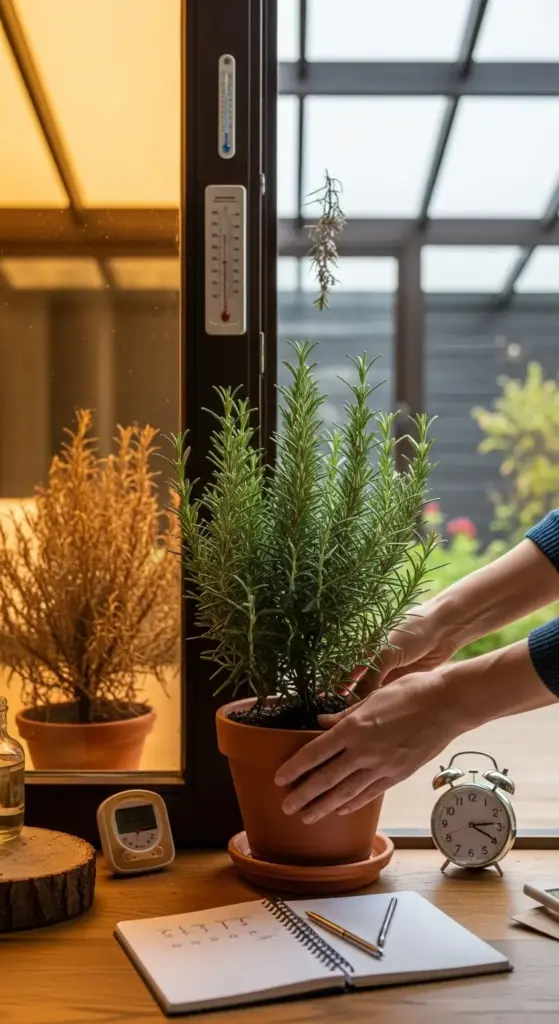5. The Temperature Shock Prevention Method

I’ll never forget the morning I found my beautiful rosemary plant completely wilted after bringing it inside for winter. One day it was thriving on my patio, the next day it looked like it had given up on life.
That’s when I learned about temperature shock the hard way. Rosemary might be tough, but sudden temperature changes can knock it flat faster than you’d believe.
The Indoor-Outdoor Transition That Saves Lives
Moving rosemary between indoor and outdoor environments is like helping someone adjust to a new time zone. You can’t just throw them into it and expect success.
I now use what I call the “two-week shuffle” method. For two weeks, I gradually expose the plant to its new environment for longer periods each day.
Week 1: Start with 2-3 hours in the new location, then back to the old spot Week 2: Increase to 6-8 hours, then overnight stays
This gradual process prevents the transplant shock that killed my first few attempts at seasonal transitions.
My Spring Transition Schedule (Hard-Won Wisdom)
Early March: Start moving containers outside during warm afternoons (above 50°F) Mid-March: Leave outside during mild nights (above 40°F) Late March: Full outdoor transition once nighttime temps stay above 35°F
I learned these specific temperatures after losing plants to late spring frosts. Rosemary can handle cold, but not sudden cold.
The Fall Indoor Move (Trickier Than You Think)
Bringing rosemary indoors for winter is actually harder than the spring transition. Indoor air is drier, light levels drop dramatically, and heating systems create temperature swings.
I start the indoor transition in early October, even if it’s still warm outside. This gives the plant time to adjust before I’m forced to bring it in due to freezing temps.
Pro tip: Place indoor rosemary near your coolest window. Most people put plants in warm, cozy spots, but rosemary prefers cooler indoor temperatures around 60-65°F.
Protecting Against Unexpected Weather Swings
Weather can be unpredictable, and I’ve learned to always have a backup plan ready. Last spring, we had a surprise late frost that would’ve killed my newly transitioned plants.
My emergency protection kit:
- Frost cloth (way better than old sheets)
- Large cardboard boxes for quick coverage
- String lights for gentle heat under covers
- Portable plant caddies for quick moves
The string lights trick works amazingly well. The gentle warmth creates a microclimate that’s just enough to prevent frost damage.
Creating Microclimates Like a Pro
Microclimates are game-changers for rosemary care. I’ve learned to create little pockets of perfect conditions even when the overall weather isn’t ideal.
Against a south-facing wall, temperatures can be 5-10°F warmer than the open garden. I use this spot for my most temperature-sensitive rosemary varieties.
Wind protection is huge too. A simple bamboo screen or even a strategically placed larger plant can prevent cold wind damage that kills more rosemary than actual cold temperatures.
Winter Care by Climate Zone (My Regional Discoveries)
I’ve moved three times and had to relearn rosemary winter care in each location. Here’s what actually works:
Zones 6-7 (where I live now):
- Container plants must come indoors
- In-ground plants need mulch and wind protection
- Expect some die-back, but roots usually survive
Zones 8-9 (my previous home):
- Most varieties survive outdoors with minimal protection
- Watch for wet winter soil – more dangerous than cold
- Prune lightly in late winter
Zones 10+ (visited friends there):
- Year-round outdoor growing
- Main challenge is summer heat, not winter cold
The Hardening Off Process (Critical Step)
Hardening off is basically plant boot camp – gradually toughening them up for outdoor conditions. I skip this step at my own peril.
For rosemary that’s been indoors all winter, I start hardening off in late March:
Days 1-3: Outside for 2-3 hours in filtered sunlight Days 4-7: Increase to 4-5 hours, some direct sun Days 8-10: Full day outside, bring in at night Days 11-14: Leave outside overnight if temps stay above 40°F
This process prevents sunscald and wind damage that can happen when pampered indoor plants hit full outdoor conditions.
My Biggest Temperature Mistake (Learn From This)
I once thought I was being smart by putting my indoor rosemary near a heating vent for “extra warmth” during a cold snap. Big mistake.
The constant hot, dry air stressed the plant so badly that it dropped half its leaves within a week. Consistent temperatures matter way more than warm temperatures.
Now I keep indoor rosemary away from heat sources and use a small humidifier nearby during dry winter months.
The Thermometer Strategy That Changed Everything
I started using min/max thermometers in different spots around my garden and house. This showed me temperature variations I never knew existed.
My “warm” south patio actually gets 15°F colder at night due to cold air settling. My “cool” north side stays more consistent. Knowledge is power when it comes to plant placement.
Emergency Frost Protection (Last-Minute Saves)
When unexpected frost threatens, I have a 15-minute emergency routine:
- Water the soil around plants (wet soil holds heat better)
- Cover with frost cloth or emergency blankets
- Add string lights under covers for gentle heat
- Secure covers so they don’t blow off
This method has saved my rosemary collection multiple times when weather forecasts were wrong.
The Gradual Light Adjustment Trick
Light shock is real and often overlooked. Moving from bright outdoor sun to dim indoor light (or vice versa) can stress rosemary as much as temperature changes.
I use sheer curtains to filter intense sunlight for newly transitioned plants. After a week or two, I remove the filter and let them adjust to full conditions.
Winter Indoor Care Secrets
Indoor winter rosemary needs different care than outdoor plants:
- Water less frequently (maybe every 10-14 days)
- Increase humidity with pebble trays
- Provide air circulation with a small fan
- Rotate weekly so all sides get light
The biggest indoor killer is overwatering combined with low light and poor air circulation. It’s a recipe for root rot disaster.
Ready to discover the exact timing that can triple your rosemary’s essential oil content? Click “next” to learn The Harvesting Timing Technique for Peak Potency – this ancient knowledge about when and how to harvest will transform your cooking and give you the most aromatic rosemary you’ve ever experienced!









GIPHY App Key not set. Please check settings